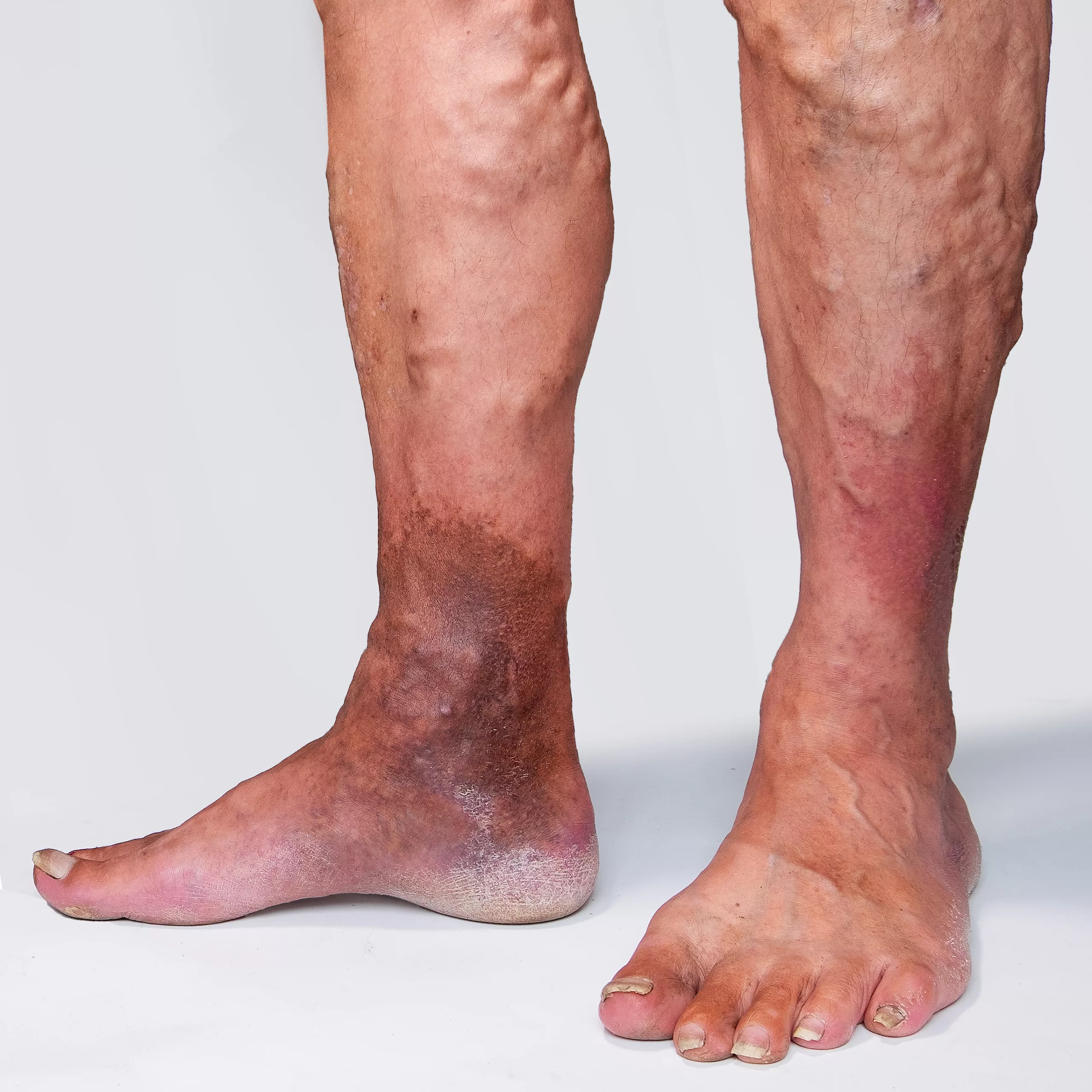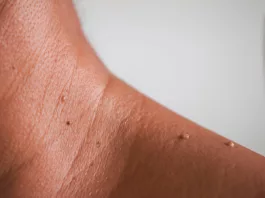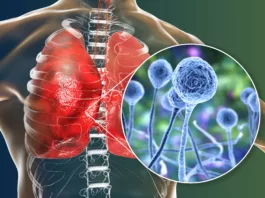What is Stasis Dermatitis?
Stasis dermatitis refers to skin changes in the legs caused by blood pooling (stasis). It typically occurs in individuals with chronic venous insufficiency, which is often associated with varicose veins, persistent leg swelling, skin discoloration, thickening and hardening of the skin (lipodermatosclerosis), and ulcers. In normal circulation, valves in the leg veins act as a pump, pushing blood back to the heart. When this mechanism fails, it leads to the leakage of water and blood into the extracellular spaces of the leg and foot. Incompetent venous return is the primary cause of this pooling, also known as stasis eczema or gravitational dermatitis.
While it is primarily an irritating condition, it can sometimes indicate the presence of serious underlying medical issues such as Chronic Heart Failure or Renal Failure. Early diagnosis and prompt treatment are crucial to prevent severe complications associated with this condition. Although rare, stasis dermatitis can also affect the upper limbs in patients with artificial arteriovenous fistulas for hemodialysis or congenital arteriovenous malformations.1Aronson, P. J., & Korman, N. J. (2023). Stasis dermatitis. In UpToDate. Retrieved June 26, 2024, from https://www.uptodate.com/contents/stasis-dermatitis?search=stasis%20dermatitis&source=search_result&selectedTitle=2%7E34&usage_type=default&display_rank=1
Symptoms of Stasis Dermatitis:
The following traits may indicate stasis eczema:
Skin Discoloration
Skin discoloration is the hallmark of stasis dermatitis, especially in the lower legs or ankles. Color changes to brown macules or patches, red spots, or ranges up to purple-tinted lesions near ankles.2Yosipovitch, G., Nedorost, S. T., Silverberg, J. I., Friedman, A. J., Canosa, J. M., & Cha, A. (2023). Stasis Dermatitis: An Overview of Its Clinical Presentation, Pathogenesis, and Management. American journal of clinical dermatology, 24(2), 275–286. https://doi.org/10.1007/s40257-022-00753-5
Yellow-brown discoloration, known as purpura jaune d’ocre, is seen in cases of chronic venous insufficiency due to hemosiderin deposits in the dermis.
Swelling/Edema
Legs and ankles develop edema due to blood pooling and extravasation of fluid.
Itching
Itchy skin is a common symptom of stasis dermatitis. Scratching due to itch leads to further desquamation of epithelium. Abrasions become the primary source of superadded infections and ulceration on the site of dermatitis.
Thickening of Skin
Prolonged stasis dermatitis leads to the thickening, scaliness, and hardening of the skin, a condition known as lichenification. The persistence of this dermatitis over time intensifies itching, contributing to the further hardening and scaling of the skin.3Ruenger, T. M. (2023, January). Stasis Dermatitis. Georg-August University of Göttingen, Germany. Retrieved from [https://www.msdmanuals.com/professional/dermatologic-disorders/dermatitis/stasis-dermatitis#v961758]
Pricking Pain
When tissues are swollen, discomfort may continue and feel “stabbing” or “needle-pricking” at times.
Causes of Stasis Dermatitis:
The main cause of this condition is long-standing edema in the legs. Physiologically, Blood is pumped upward by one-way valves in your leg veins to prevent blood from accumulating in your lower extremities. When the integrity of the valves deteriorates either due to age or any other underlying medical condition, it could prevent them from operating efficiently. As a result, venous insufficiency or lymphedema (oozing of blood to extracellular spaces) occurs in the lower extremities. This long-standing pooling of blood is the primary cause of stasis dermatitis.
Different causes of venous insufficiency that leads to stasis dermatitis include:
- Compromised Venous Valves
- Varicose veins
- Chronic Hypertension
- Deep Vein Thrombosis
- Obesity (Very High BMI)
- Congestive Heart Failure
- Renal Failure (Kidney failure)
- History of Surgery or Trauma
Who is at Risk of Stasis Dermatitis?
Anyone who suffers from poor circulation is at increased risk of developing Stasis dermatitis. Venous insufficiency is also vulnerable to an increase in age.
- Age > 50 years
- Females > Males
- Pregnant woman
- Obese individuals
- Patients with cardiovascular disease history
- Patients with chronic kidney disease
- Lifestyle factors like little physical activity or having a job that involves hours of sitting or standing
How is it Diagnosed?
Diagnosing venous stasis dermatitis involves a comprehensive examination of the legs and skin conducted by your healthcare provider. This examination is crucial for assessing the characteristic skin changes associated with blood pooling in the affected areas.
In addition to the physical examination, healthcare providers may employ specific diagnostic tests to gain further insights into the condition. One commonly used test is ultrasound, which serves the dual purpose of ruling out the presence of blood clots and evaluating potential damage to the blood vessels in the legs. Ultrasound results contribute to a more detailed understanding of the circulatory dynamics in the affected regions.4Sundaresan S, Migden MR, Silapunt S. Stasis Dermatitis: Pathophysiology, Evaluation, and Management. Am J Clin Dermatol. 2017 Jun;18(3):383-390. doi: 10.1007/s40257-016-0250-0. PMID: 28063094.
Your healthcare provider may order allergy testing in some cases. These tests help ensure that the skin symptoms observed are not a result of an allergic reaction. A skin biopsy is usually not required to diagnose stasis dermatitis. However, in cases where the diagnosis is unclear, or the patient has unusual symptoms (such as a single lesion or no involvement of the ankle), a biopsy and histopathological examination can help confirm the diagnosis and rule out other skin conditions like allergic contact dermatitis, asteatotic eczema, or skin cancer.
Management of Stasis Dermatitis
Management of stasis dermatitis is primarily conservative. Self-care is a crucial step for long-term recovery. If the leading cause of stasis dermatitis is venous insufficiency, the doctor might advise surgical management of the primary cause.5Norman, Robert, and Patrick Brennan, ‘Integrative Management of Stasis Dermatitis,’ in Robert A. Norman, Philip D. Shenefelt, and Reena N. Rupani (eds), Integrative Dermatology, Weil Integrative Medicine Library (New York, 2014; online edn, Oxford Academic, 1 Aug. 2014), https://doi.org/10.1093/med/9780199907922.003.0026, accessed 12 Oct. 2023
Conservative Therapy:
This approach focuses on non-invasive methods to manage symptoms and improve quality of life.
Compression Stockings
The doctor or dermatologist will likely advise you to wear a pair of compression stockings. These pressure stockings promote proper venous blood flow, reducing the likelihood of blood pooling in the lower limbs and enhancing overall blood circulation to alleviate edema.6Raju S, Hollis K, Neglen P. Use of compression stockings in chronic venous disease: patient compliance and efficacy. Ann Vasc Surg. 2007 Nov;21(6):790-5. doi: 10.1016/j.avsg.2007.07.014. PMID: 17980798.
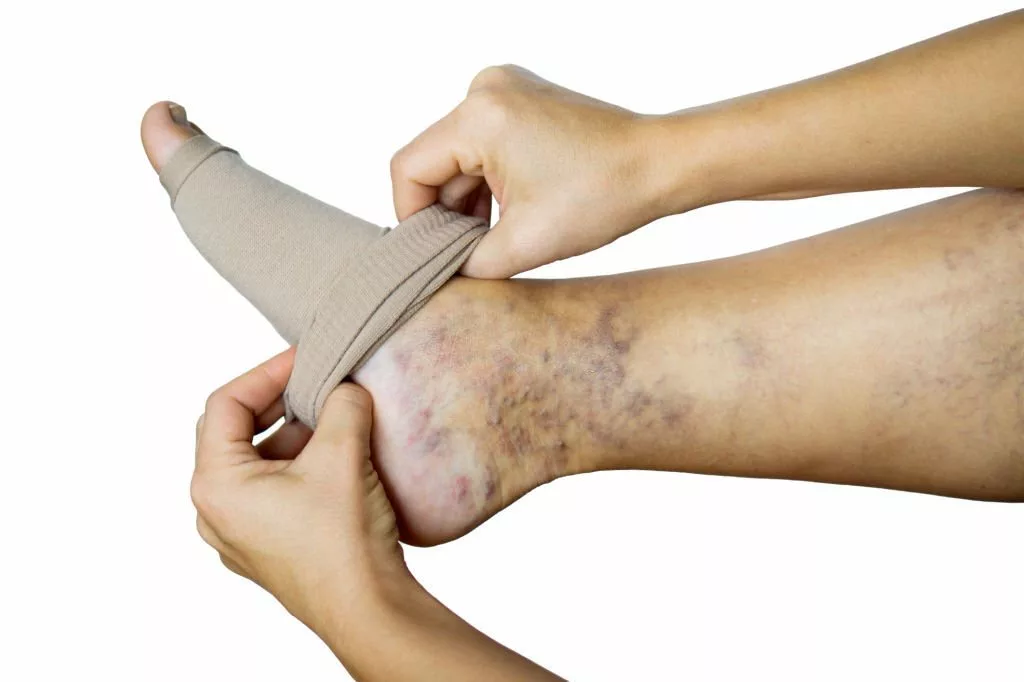
Steroids
A mid-potency topical corticosteroid (triamcinolone acetonide 0.1% cream or ointment) frequently relieves non-eroded stasis dermatitis. Typically, topical corticosteroids are applied during acute flares to lessen itch and edema.
Antibiotics
Topical antibiotics are combined with topical corticosteroids to aid in healing and avoid superadded bacterial infections. Usually, 0.1% triamcinolone ointment is considered an effective regime. Moreover, no association is found between regular use of oral antibiotics and slowing bacterial colonization in patients with stasis dermatitis.7American Academy of Family Physicians. (n.d.). Antibiotics for Stasis Dermatitis. In Choosing Wisely. Retrieved from https://www.aafp.org/pubs/afp/collections/choosing-wisely/255.html
Topical Anesthetic Application
The most widely utilized medications include topical anesthetic creams to manage the burning sensation of the lesions. Lignocaine and lidocaine, sometimes in combination with oral analgesics like acetaminophen and anti-inflammatory medications like NSAIDs, are effective.8Sundaresan, S., Migden, M. R., & Silapunt, S. (2017). Stasis Dermatitis: Pathophysiology, Evaluation, and Management. American Journal of Clinical Dermatology, 18(3), 383–390. https://doi.org/10.1007/s40257-016-0250-0
Emollients
Patients with chronic stasis dermatitis are primarily treated with local emollients like petrolatum and lanolin. These emollients produce a strong skin barrier that reduces the initiation of itching and ulceration.
Dressing
Topical dressings are effective for treating ulcerative stasis dermatitis. A hydrocolloid dressing may most effectively treat a weeping (eroded) lesion.
Most topical medicines are used alone or in combination with compression therapy for their treatment.
Foot-end elevation:
- Extend your legs beyond your heart’s level.
- Every two hours, carry out this in 15-minute intervals.
- Legs can be raised using pillows while you sleep.
Supportive Therapy
Supportive therapy aims to improve treatment outcomes.
Take Small Breaks
If your work requires sitting and standing for a long time, take small breaks. For example, take a brisk walk for 10 minutes.
Avoid Long Standing Position
Don’t remain in a standing position for an extended period. Take frequent strolls.
Wear Comfortable Clothes
Compression stockings are a good choice for varicose legs. As for the remaining body, opt for loose-fitting clothing.
Self Care
- Your skin gets easily irritated, so use gentle cleansers and soft fabric towels.
- The use of emollients is recommended.
- Diet modification, especially avoiding high-salt foods.
Avoid Scratching
Regardless of how itchy the affected skin is, take all required precautions to prevent scratching.
Additionally, if your itching is terrible, try taking an oatmeal bath, coating the area with petroleum jelly and steroid cream, or putting a cool compress on the region for 15 minutes. In the long run, scratching causes skin cracks that are readily infected.
Good Hydration
Getting enough hydration helps your blood volume remain high, which reduces edema and promotes circulation.
The ideal daily water intake for men and women is 2.7 liters and 3.7 liters, respectively.
Maintain your Blood Pressure
Elevated blood pressure may worsen stasis dermatitis. To maintain healthy blood pressure levels, your doctor may advise you to regularly exercise, take medication, or engage in other preventive practices. Consult your doctor about diuretics to reduce leg edema and manage blood pressure.
Maintain Ideal Weight
Weight loss is necessary to manage this condition. You can work with your physician or other medical professionals, such as a qualified dietitian, to reach and maintain a healthy weight.
A healthy weight can significantly improve the function of your circulatory system and reduce swelling. Maintaining a food journal in which you note what you eat and drink (and how much of each) may also be beneficial.
Add-on Supplements
Patients with stasis dermatitis should take supplements like vitamin C and rutin. These boost blood vessel health. Horse chestnut extract is also of significant importance.
Complications of Stasis Dermatitis:
If left untreated or poorly managed, stasis dermatitis can lead to various complications.9eMedicine. (n.d.). Stasis Dermatitis. Medscape. Retrieved from [https://emedicine.medscape.com/article/1084813-overview?form=fpf] Some potential complications include:
Venous Leg Ulcer
If stasis dermatitis persists chronically, it develops permanent venous leg sores (ulcers). These ulcers complicate the form of gangrene of the leg that needs surgical intervention.
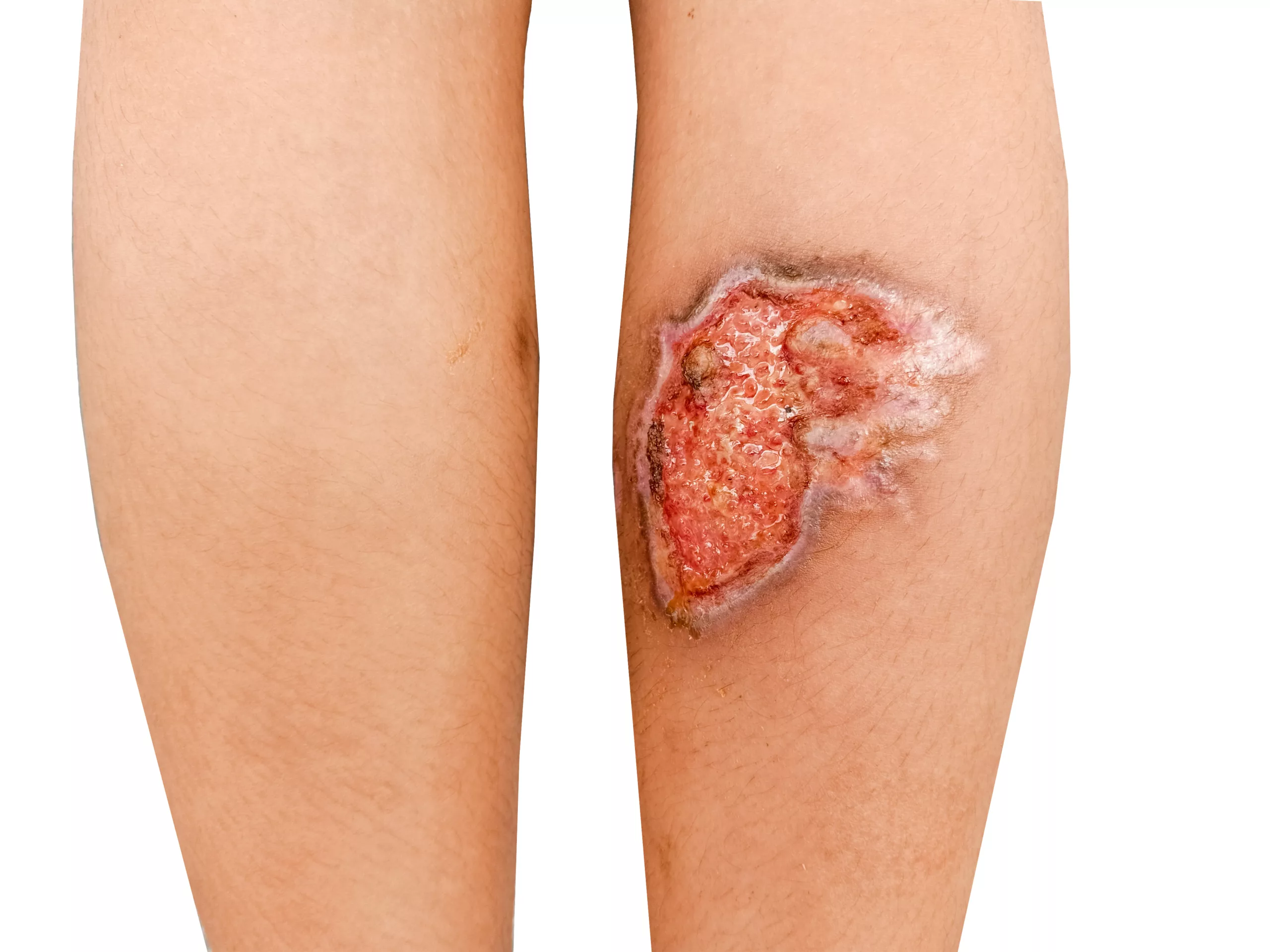
Cellulitis
Superadded infections on eczematous skin may lead to cellulitis, which, if not treated on time, may result in severe systemic illness.
Skin atrophy
Thinning of the skin, eczema, and ulceration can lead to skin atrophy, making the surrounding skin more vulnerable to injuries and tears.
Conclusion
The lower extremities of older people frequently experience stasis dermatitis, the cutaneous manifestation of venous hypertension brought on by venous reflux.
Compression therapy is the cornerstone of treatment. It combines topical therapies to address secondary skin changes and their accompanying signs and symptoms. Basically, compression therapy reduces discomfort and swelling.
Regularly visiting a dermatologist and taking his prescriptions and advice will improve patients’ overall quality of life.
Refrences
- 1Aronson, P. J., & Korman, N. J. (2023). Stasis dermatitis. In UpToDate. Retrieved June 26, 2024, from https://www.uptodate.com/contents/stasis-dermatitis?search=stasis%20dermatitis&source=search_result&selectedTitle=2%7E34&usage_type=default&display_rank=1
- 2Yosipovitch, G., Nedorost, S. T., Silverberg, J. I., Friedman, A. J., Canosa, J. M., & Cha, A. (2023). Stasis Dermatitis: An Overview of Its Clinical Presentation, Pathogenesis, and Management. American journal of clinical dermatology, 24(2), 275–286. https://doi.org/10.1007/s40257-022-00753-5
- 3Ruenger, T. M. (2023, January). Stasis Dermatitis. Georg-August University of Göttingen, Germany. Retrieved from [https://www.msdmanuals.com/professional/dermatologic-disorders/dermatitis/stasis-dermatitis#v961758]
- 4Sundaresan S, Migden MR, Silapunt S. Stasis Dermatitis: Pathophysiology, Evaluation, and Management. Am J Clin Dermatol. 2017 Jun;18(3):383-390. doi: 10.1007/s40257-016-0250-0. PMID: 28063094.
- 5Norman, Robert, and Patrick Brennan, ‘Integrative Management of Stasis Dermatitis,’ in Robert A. Norman, Philip D. Shenefelt, and Reena N. Rupani (eds), Integrative Dermatology, Weil Integrative Medicine Library (New York, 2014; online edn, Oxford Academic, 1 Aug. 2014), https://doi.org/10.1093/med/9780199907922.003.0026, accessed 12 Oct. 2023
- 6Raju S, Hollis K, Neglen P. Use of compression stockings in chronic venous disease: patient compliance and efficacy. Ann Vasc Surg. 2007 Nov;21(6):790-5. doi: 10.1016/j.avsg.2007.07.014. PMID: 17980798.
- 7American Academy of Family Physicians. (n.d.). Antibiotics for Stasis Dermatitis. In Choosing Wisely. Retrieved from https://www.aafp.org/pubs/afp/collections/choosing-wisely/255.html
- 8Sundaresan, S., Migden, M. R., & Silapunt, S. (2017). Stasis Dermatitis: Pathophysiology, Evaluation, and Management. American Journal of Clinical Dermatology, 18(3), 383–390. https://doi.org/10.1007/s40257-016-0250-0
- 9eMedicine. (n.d.). Stasis Dermatitis. Medscape. Retrieved from [https://emedicine.medscape.com/article/1084813-overview?form=fpf]

